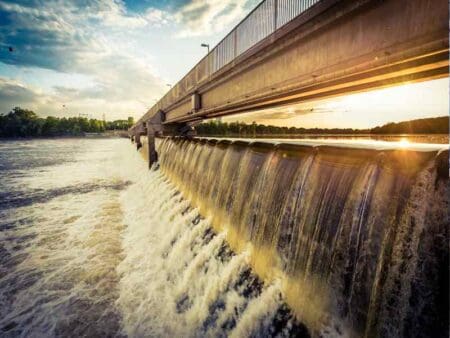
Across the sweep of the US water, wastewater and stormwater utility industries, challenges – some old, some new – continue to test the sector, amplifying the need for more robust resilience.
As if floods, fires, drought and extreme weather such as February’s disruptive deep freeze in Texas weren’t enough, the COVID-19 pandemic hit the industry last year seemingly out of the blue, creating uncertainty about safety while straining the bottom lines of many water utilities.
Despite that, the industry rose to the challenge, demonstrating remarkable agility and adaptability through its front-line professionals to keep the water flowing – true to its mission of delivering a clean, reliable and safe supply.
All the while, cybersecurity concerns continue to loom large, along with the sector’s chronic headache: what to do with an infrastructure well past its prime.
Black & Veatch’s 2021 Strategic Directions: Water Report, based on expert analyses of a survey of more than 200 US water sector stakeholders, examines those complexities in the transforming water, wastewater and stormwater industries striving to advance “One Water,” the premise that integrated and holistic water resource management — the value of all water regardless of history — must be considered when drafting plans and making investment decisions.
Technological advances from process intensification to data analytics and artificial intelligence continue to light a path forward, helping utilities and industry optimise asset performance, reduce costs, save energy, achieve regulatory compliance and bolster security.
More than ever, utilities are compelled to unleash the value of data and analytics in their operations to drive better decision-making, with heightened resilience as the end game. While consumers are sounding the call for more robust systems, the survey’s responses make clear that there’s more work to be done.
Amid infrastructure aging cConcerns, ‘Digital Water’ is key
To little surprise, three-quarters of survey respondents cited aging infrastructure as their foremost challenge in a chronically underfunded industry, far outdistancing issues such as making the case for capital improvement programs (34 percent), system resilience (30 percent) and managing capital costs (26 percent) (Figure 1). Resilience’s showing was up one spot from last year when one-quarter of respondents listed it among their three most challenging issues.

As utilities within the water industry continue to grapple with doing more with less, digital solutions can be a game-changer. Leveraging digital technology can harness data precisely, leading to enhanced capabilities in tracking consumption, driving customer engagement, optimising performance and prioritising investment dollars. Greater sustainability and resilience through informed asset management and planning are the benefits, along with an invaluable, holistic view of the water system.
Without question, data can guide utilities to higher operational efficiency, greater performance predictability, and better maintenance planning, along the way, boosting insight about when, where and how much to invest in systems. The opportunity to gather and integrate information using current data-collecting systems — complemented with evolving next-generation, cost-effective sensors and smart devices — enables predictive analytics to detect leaks, forecast usage, reduce costs and everything in between.
What’s not to like. But Black & Veatch’s survey shows that many utilities are missing out, harvesting more data but lacking insights about what to do with it all. Some two-thirds of respondents categorize their data management practice as robust and strengthening but not fully integrated, up slightly from a year earlier. An additional three in 10 respondents say their data is unintegrated and siloed, consistent with the 2020 survey. Just 5 percent called their data management robust and fully integrated.
In a separate question, half of the respondents say they’re collecting lots of data but not effectively leveraging it to actionable information, down from 60 percent in 2020 (Figure 2).

The bottom line: Siloed data keeps utilities from having a complete, clear picture of their assets and operations and how best to invest in them.
Still, utilities are exploring other digital options, including digital mapping to catalog utility systems and assets – evidence that digital technology is taking a firmer hold across the water and wastewater industry.
COVID-19 and the water sector
Across the spectrum of water services, the COVID-19 pandemic’s impact was profound the instant it began its spread through the U.S. in early 2020.
Industries and businesses shuttered, forcing tens of millions of layoffs that, in turn, produced delinquencies in water bills, cutting into the revenues and cash flows of utilities of all sizes. By and large, they suspended water and wastewater shutoffs to past-due accounts, both as a humane gesture and as an acknowledgment of the importance of water and sanitation during a health crisis, regardless of one’s ability to pay. Some utilities forgave the unpaid amounts; others deferred them.
Have you read?
Black & Veatch report addresses water sustainability
US utilities to intensify digital water programmes – here’s why
Consumer happiness and decarbonisation drive ‘new energy concept’
Closures of big commercial and industrial water customers adversely impacted utility revenues and cash flows as water demand shifted to residential areas, where displaced workers suddenly found themselves working remotely.
Two-thirds of respondents to Black & Veatch’s survey reported that the outbreak had at least a moderate impact on their day-to-day operations. But the sector weathered the storm and learned from it, demonstrating admirable agility and adaptability.
More than two-thirds of respondents credited COVID-19 for their organization’s increased consideration of technology, pointing to the pandemic-forced remote working practices of their employees. Thirty-two percent report giving more thought to customer engagement, with 29 percent saying they’re supporting increased remote operations and automation (Figure 3).

As the survey shows, utilities appear to be moving beyond their historical business activities and increasing their engagement with digital and electronic management approaches. Water, wastewater and stormwater utilities found that perhaps their data management wasn’t as robust as they thought during the operational challenges of COVID-19, inspiring them to ramp up efforts to harness and optimize the use of information.
Despite its impacts, the pandemic amplified the opportunity and need to accelerate innovation in strategy, operations and funding to protect human health and the environment, along the way greasing the economic engine that comes from infrastructure investment.
Resilience must be a priority
More than ever, the industry is at a crossroads to invest in its systems and pursue greater resilience manifested in so many forms, from financial resilience to the operational and strategic varieties. Yet again, there’s work to be done on that.
When respondents were asked to prioritize projects by their organization, those meant to ensure or enhance water quality — the chief mandate of water providers — held the most sway, with roughly four in 10 casting that as the highest prioritization. Efforts to bolster the conditions of assets or to replace them altogether was the principle priority of one-quarter of respondents, followed by addressing capacity and growth (17 percent) and operations and efficiency (12 percent). Projects meant to bolster resiliency drew just 5 percent, with nearly three in 10 labeling resilience as their lowest priority.
The takeaway: Many system managers direct their energy and focus on meeting state and federal water quality standards and simply keeping the system running. For managers, any issues beyond the job’s operational requirements tend to get kicked down the road as “tomorrow’s crisis” — something to address only after today’s crises are managed.
Nonetheless, utilities would be wise to leverage new funding sources, collaborate with partners, plan systems holistically and prioritize water as a way to revitalize, rejuvenate and equitably build our communities of tomorrow, with an eye on hardening their systems against a growing array of challenges.
Find out more about the study.
About the author
Cindy Wallis-Lage is president of Black & Veatch’s water business, leading the company’s efforts to address water infrastructure needs around the world. A global champion for the world’s water resources, she advocates understanding water’s true value and promoting its resilience so that communities may achieve their social, economic and environmental sustainability goals. Wallis-Lage has been involved in more than 100 projects worldwide, helping public and private entities successfully develop, enhance and manage their water, wastewater and stormwater facilities and infrastructure.








